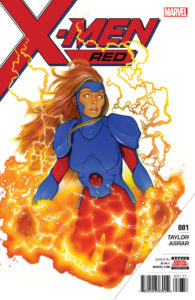
X-Men: Red #1
Writer:
Tom Taylor
Artist:
Mahmud Asrar
Colorist: Ive Svorcina
Letterer: VC’s Cory Petit
Cover Artist: Travis Charest
Publisher: Marvel Comics
 Review by Nico Sprezzatura
Review by Nico Sprezzatura
With the return of Jean Grey bringing X-Men’s “ResurrXion” to an end, it’s time for our favorite group of crime-fighting mutants to move forward, and this week’s X-Men: Red #1 has major designs on the franchise as they proceed. Should you join them?
When X-Men: Red was announced with Tom Taylor and Mahmud Asrar heading its creative team, I was already sold on the strength of those creators. Taylor’s currently ongoing All-New Wolverine has been a consistent delight since it launched, while Asrar is one of our most reliable superhero artists of the modern era. Throw in a diverse mix of characters, and this title practically sells itself.
But based on this first issue, I wasn’t expecting X-Men: Red #1 to be as political as it is, which is a major point of difference between it and the rest of the current X-Men slate. With the exception of a brief storyline in X-Men: Gold a few months ago, and the inherent implications of Iceman’s gay lead, the ResurrXion line overall has been fairly apolitical, which I’d argue has been to its detriment.
This isn’t necessarily a bad thing. Unbeatable Squirrel Girl, for example, is an upbeat piece of fluffy superhero fiction, and doesn’t suffer for it. The difference between Squirrel Girl and X-Men, however, is that the latter were very expressly designed for political allegory by Jack Kirby and Stan Lee. Cullen Bunn and Marc Guggenheim (of Blue and Gold, respectively) haven’t been overly interested in leaning into the “protecting a world that hates and fears them” hook that’s defined the team for decades, and that’s fine. Not every X-Men story has to hit you over the head with political messaging, and some of the best (“Inferno,” “Dark Phoenix Saga,” et. al.) don’t… but in the year 2018, maybe they should?
As an oppressed and feared minority, mutants live and die —often literally, as nearly seen in Red #1— by their “identity politics.” Despite all the progress made for mutant rights and acceptance on a sociological level, there are still plenty of people who hate them for simply existing. Sound familiar to you? Perhaps now more than ever, it’s important for X-Men comics to reflect the world as it is, and while Blue & Gold have been taking walks on that pitch, it seems Red isn’t as willing to play thematic softball in its first outing.
X-Men: Red #1 is very much a table-setting issue, perhaps on purpose. There’s no way you can assemble an entire new team of X-Men in just twenty-odd pages, so Taylor doesn’t bother trying. Instead, he utilizes the classic “how we got here” plot for this first arc, showing how (and why) the newly-resurrected Jean decides it’s on her to help save mutantkind from a hostile world that still contains bigotry. Without getting into specifics, Jean works to have a global mutant nation recognized by the UN, and it goes just about as well as you’d expect. (It doesn’t.) And that’s not even mentioning the arrival of a familiar baddie, who will surely make Jean’s goal all the more difficult to achieve.
While this issue doesn’t touch on some key questions I have (i.e. how long has Jean been alive? Does everybody in the Marvel Universe know she’s alive again? Who is Trinary and what are her powers?) I’m sure they’ll be addressed later down the line, and I trust Taylor as a writer to do so.
I also really enjoy the roster he’s chosen for this series. It’s a mix of older favorites (Jean, Nightcrawler, Namor), some newer faces (Laura Kinney’s Wolverine, her sister-clone Honey Badger), and a scattering of obscurer mutants (Wakandan native Gentle, new character Trinary). Plus —SPOILER ALERT!— Gambit will be jumping on board sooner rather than later. A team book like this is almost entirely dependent on its roster, and I have a feeling X-Men: Red won’t suffer in that regard.
Asrar’s art is also very good here, which I more or less expected. There’s a youthful energy to the way he draws his characters —which works especially well for Honey Badger— without them seeming juvenile or kiddish. There are some spots where Asrar’s facial rendering is a bit spotty, but I’m sympathetic to the demands of a monthly comic book’s schedule, so it ultimately didn’t bother me while reading. Ive Svorcina’s coloring works really well with Asar’s colors, painting them with vibrant hues straight out of a cartoon.
The Verdict:
Buy it! With a much-needed boldness and sense of urgency missing from the ResurrXion slate, X-Men: Red #1 lives up to its namesake color in a major way.


![[EXCLUSIVE PREVIEW AND INTERVIEW] FIRST LOOK AT LIVEWIRE #7](https://geekd-out.com/wp-content/uploads/2019/05/LIVEWIRE_007_COVER-A_ROCAFORT-1-e1558326462419-150x150.jpg)
![[REVIEW] AVENGERS #33](https://geekd-out.com/wp-content/uploads/2020/05/avengers-33-feat-150x150.png)
One thought on “X-Men: Red #1 Review”